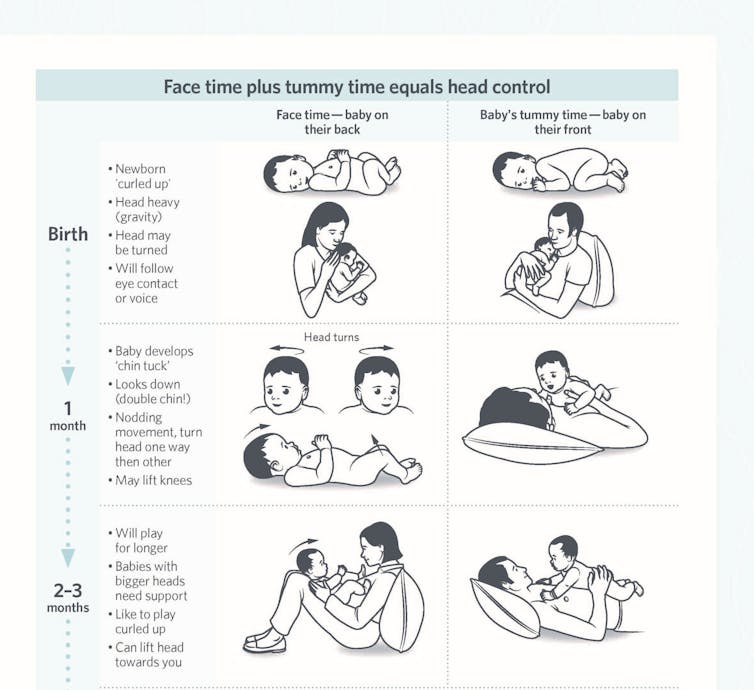Babies need more than tummy time to strengthen necks and prevent flat heads.

Tummy time is important for strengthening infants’ necks, but it’s not all they need.
from www.shutterstock.com
Elizabeth Williams, University of Melbourne and Mary Galea, University of Melbourne
Supervised, awake tummy time is recommended to facilitate a baby’s development and minimise flat head syndrome.
But some babies don’t like tummy time, and will kick up an almighty fuss to let you know.
Luckily, tummy time is not all you can do to get your baby moving.
What is flat head syndrome?
Flat head syndrome, or “plagiocephaly”, occurs when the baby’s soft skull can mould and cause a flat spot at the back of the head, or a bulge at the forehead. This is due to gradual pressure on the back of the head from the baby lying on that spot as the head grows rapidly.
Plagiocephaly is surprisingly common, affecting 46.6% of infants at 7-12 weeks and 50% at six months. One study found 80% of infants were considered normal by five years of age.
In more severe cases, the baby may be prescribed an orthotic helmet; but this is controversial and parents have reported problems such as child stress and high costs. In 2014, a randomised controlled trial discouraged the use of helmets, but the same year a study reported 95% improvement in asymmetry with helmet therapy.
Studies have shown three-year-olds with plagiocephaly had statistically significant delays in cognitive, language and adaptive behaviours. Another study of three to five year-old children found postural changes and poor balance compared to children without flat head syndrome.
A systematic review of flat head syndrome and developmental delay concluded flat head may be a marker of developmental needs requiring early intervention.
Just tummy time isn’t enough
Supervised tummy time, or rolling the child onto their stomach, has long been recommended, although currently there are no national guidelines regarding the frequency and duration of tummy time an infant should receive.
Tummy time helps strengthen babies’ necks. It gets them off the back of their heads where flatness can occur and leads to strengthening of the extensors (straightening muscles) in the back of the neck, which hold the head up when babies are on their stomachs.
Some research found tummy time alone is not enough to prevent flat heads. In addition to tummy time, parents should encourage “face time” to strengthen the muscles at the front of the neck to enable baby to move their head while on their back.
Face time is challenging for the baby as it requires the flexor (curling up) muscles to coordinate the head to lift it forward towards you, and against gravity.
Face time can be done when baby is awake by supporting them in front of you “face to face” and engaging them with direct eye contact. If they are happy and settled they will follow your eyes to the side and, if you keep eye contact, turn their head to see you.

Even newborns will be able to move their heads from side to side to keep your eye contact.
from www.shutterstock.com
Previous studies have shown reduced plagiocephaly rates when parents prepared the environment to allow free and spontaneous movement (such as placing the baby on a mat when they’re awake), when infants spent less time in carriers, and when parents were aware of the infant’s head position. This research adds specific advice for active head movement that can become part of daily activities.

Head control fact sheet (detail) – Royal Children’s Hospital
Both tummy time and face time can be started from birth. Tummy time can be face time as well if you lie down with them on your stomach. When they can hold their head up themselves in tummy time they can go on a mat with some toys for short sessions.
If they’re upset, get down and play with them to see if they settle, otherwise you need to pick a better time when they are active and awake.
What parents should know
It’s important to follow safe sleeping advice, which specifies a baby should sleep on their back. Along with this, parents should interact with their baby as in the above illustrations and know:
- even newborn babies can move their head to each side by following their parents’ eye contact or their voice and they should be encouraged to do so
- from birth, babies need both tummy time and face time when they are awake and happy
- baby’s head should be supported until they can hold it themselves.
![]()
The best way to encourage babies to be more active is to play with them, provide tummy time and engage face to face with eye contact, smiles and talking, from birth.
Elizabeth Williams, PhD Candidate, University of Melbourne and Mary Galea, Academic Director, Australian Rehabilitation Research Centre, Royal Melbourne Hospital,Professorial Fellow, Department of Medicine (Royal Melbourne Hospital), University of Melbourne
This article was originally published on The Conversation. Read the original article.
We may get commissions for purchases made using links in this post. Learn more.























-

-
-
-
Blossom said
- 01 Sep 2018
-

-
-
-
Ellen said
- 22 Aug 2018

-

-
-
-
mom101628 said
- 21 Aug 2018
-

-
-
-
ashna9 said
- 21 Aug 2018
-

-
-
-
mom74005 said
- 21 Aug 2018
-

-
-
-
mom265671 said
- 21 Aug 2018
-

-
-
-
MuthaNita said
- 21 Aug 2018
-

-
-
-
Mum2archer said
- 21 Aug 2018
-

-
-
-
mom114371 said
- 21 Aug 2018
Post a comment8:50 pm
4:13 am
9:37 pm
8:47 pm
5:17 pm
3:47 pm
1:02 pm
11:40 am
11:21 am
To post a review/comment please join us or login so we can allocate your points.